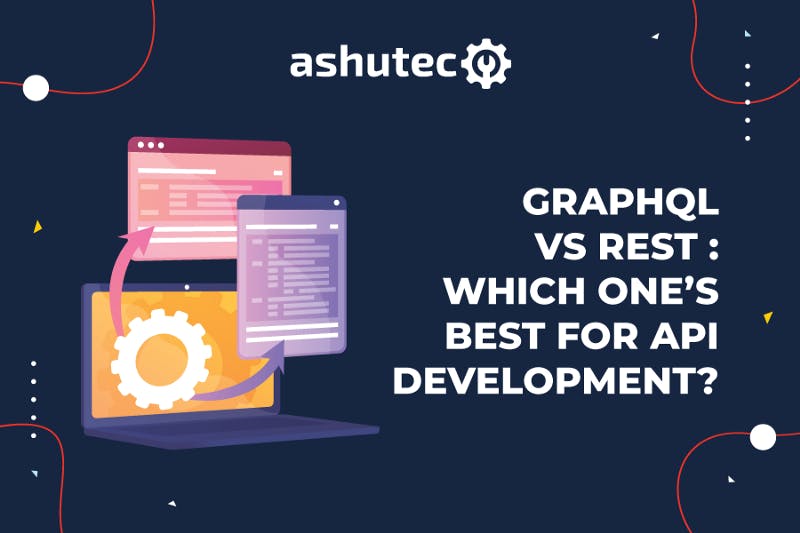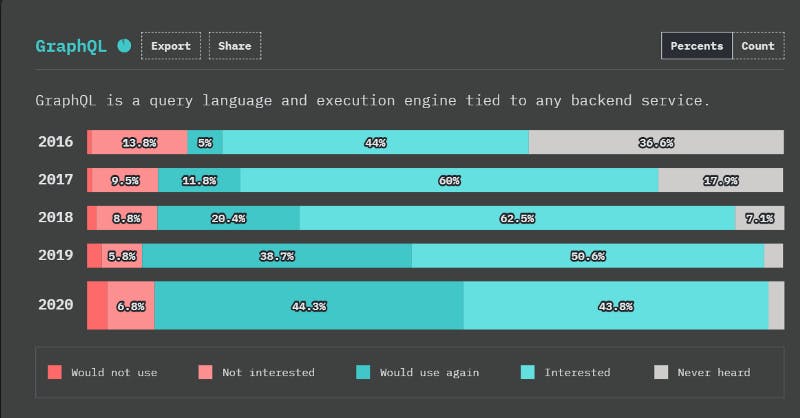Let’s Connect!
Work can be a fun when we know and understand each other well. Let's start conversation to new beginning
+91 63542 35108
To discuss what we can do for you Give us a Call
connect@ashutec.com
Tell us about your next project Write to us

Often referred to as a revolutionary alternative for API design and development, GraphQL presents a modern approach over REST. GraphQL and REST both are used for data retrieval and sending data over HTTP. However, the REST is a traditional way of doing things with a high rate of adoption while GraphQL presents a better alternative overcoming the shortcomings of its rival.
The argument is getting intense as most developers or users of both technologies are equally participating in this raging war. This has torn businesses apart and left them confused about which API creation technology they should utilize. That’s why the ashutec team has come up with a guide to help you decide which API development technology is better for your software development project.
Before we get into the comparison guide, let’s quickly understand the basics first, starting with what is API.
An API, short for Application Programming Interface, constitutes a group of protocols to integrate different parts of the application for easy data retrieval. It is a contract between the data provider and receiver, and other communication parameters such as requests to make, how to make them, different kinds of responses, data types to retrieve, etc.
In essence, it is a technology that simplifies the communication between two systems of an application and helps them talk to each other when a request is made. REST and GraphQL are two prominent API design, development, and integration approaches.
Representational State Transfer or REST has become a standard for most developers and companies for deploying APIs. The technology is focused on the data resources and leverages the HTTP conventions rather than fighting HTTP.
The best thing about REST is the developers working on someone’s API don’t necessarily need any libraries or special initialization. In REST architecture, resources such as services, data, or objects have their own unique URI (Uniform Resource Identifier), which clients can access through sending a request.
What this does is whenever a client requests using RESTful API, a representational queried resource is presented by the server. REST uses CRUD HTTP verbs (GET, POST, PUT, DELETE) for query requests on servers.
GraphQL is a query language for clients to request and get responses from the application. Also, it is used for runtime execution to process query requests on the server. As the name suggests, a set of information is presented in the form of a graph. Objects in GraphQL are represented by the schema system that defines nodes, which are used for increased connectivity between objects.
The technology allows clients to request data from several different resources through a single request instead of multiple requests to fetch data. The biggest advantage of GraphQL API development technology is clients can specify the exact type of data required — not more, not less. Moreover, such a predictable structure of data is efficient and easy to read by clients.
GraphQL and REST both are created to resolve the same problem but with different approaches. As mentioned, they are API design methods that fulfill the purpose of data transmission and retrieval from one endpoint to another. However, the execution from both technologies varies greatly from each other.
So, when it comes to choosing from either of the two approaches, you’ll have to consider a few key factors as listed below:
Technology that is community popular and tested by the community members is likely to be more stable. Moreover, adopting the community-popular technology is more advantageous as you’ll get support for any problems during implementation.
Since the REST has been here for a while, it is way ahead of GraphQL in community support and popularity. However, being the new kid, GraphQL is trying to catch up to the level of REST quite quickly and has already established itself as an innovative API design technology.
GraphQL’s popularity is proliferating, which can be seen in the State of JavaScript Survey 2020 report where GraphQL tops the ranking. Also, the report stated a little over 44% would use GraphQL again and over 43% are interested in the technology. The below image further shows the increase in popularity of GraphQL over the past five years. From these, we can conclude GraphQL is here to stay.

The performance of both technologies is another widely contested topic to rage the REST vs GraphQL war further. REST is widely criticized for its inclination toward over and under-fetching of the requested data. To fetch proper data, you may have to make multiple requests due to the rigid data structure that returns unnecessary or improper data.
GraphQL, on the other hand, performs better and handles the request efficiently to provide the exact type of information specified in a single API call. The technology is so advanced that it will return only requested information from the server once the data type required is defined, avoiding the over or under-fetching of data.
Another performance aspect is caching, where REST has a built-in HTTP caching mechanism for faster responses and GraphQL has to return to the source to retrieve data. GraphQL has to rely on 3rd party cache sources to be at the same level as REST.
Since GraphQL is a relatively new API design approach, it does not have the same level of security measures as REST. However, this does not imply that GraphQL is not secure at all. As the technology is getting advanced, more and more security measures are being added. Both technologies can use the JSON Web Tokens (JWT) to authenticate users and send sensitive information as JSON data structures.
While REST also can do so with HTTP authentication or via OAUTH 2.0 merchants. Through HTTP, the data is sent as HTTP headers. Such level of security on GraphQL is still complicated, however, new developments are under construction to improve the security in API design.
As mentioned, the main purpose of using GraphQL or REST in API is to fetch data. While REST can fetch data by accessing multiple endpoints, GraphQL can do so with a single query endpoint to fetch multiple data types.
The most common problem with REST is over and under fetching of the data required, where GraphQL seems to have an upper hand. APIs designed with REST can’t provide exact data types to the clients, which is why the clients have to download the data through multiple endpoints with the fixed data structures.
Over fetching refers to downloading more information than what is actually requested in a query. For instance, a request to only see user names through an API in a software application may return more information such as date of birth, address, etc. about users. Such information is useless most of the time if the request is only to display user names.
Another issue with REST is under fetching, in which the data provided by a specific endpoint is not adequate. Therefore, the client has to perform additional calls for the API to fetch proper data.
All such trouble is avoided when GraphQL is used for API development. The query language tailors its approach to provide end-users with the exact data requested out of it. It presents data from multiple objects through a single request to show a specific data field. The only catch is you have to specify what data is required beforehand.
To sum it up, GraphQL is way better and more powerful than REST for fetching accurate data from the system. Further, it saves the processing power required, which can add up to make the API-driven software more economical.
The answer to the question which technology is better for API development out of REST and GraphQL is very subjective. Your choice can largely depend on your software application’s requirements. GraphQL is the way to go if you want a fresh approach to fetch accurate data without multiple rounds of requests, avoiding over or under-fetching.
While REST is popular and has a native caching mechanism along with authentication capability, GraphQL is slowly but steadily catching up to it and may become the market leader one day. Thus, the choice is yours if you know the constraints and tradeoffs of each technology and are ready to make your way around it.

